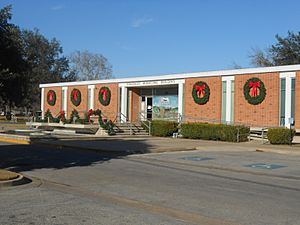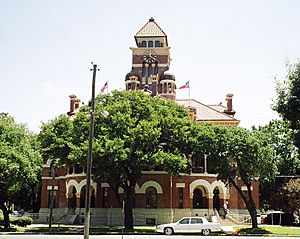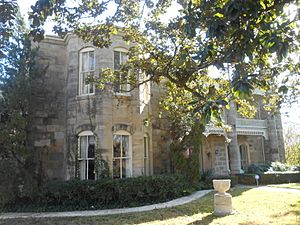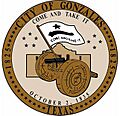Gonzales, Texas facts for kids
Quick facts for kids
Gonzales, Texas
|
|||
|---|---|---|---|

Gonzales' Municipal Building on St. Joseph St. was built in 1959 from plans by Emil Niggli and Barton Riley.
|
|||
|
|||
| Motto(s):
"Where the fight for Texas liberty began"
|
|||
| Subregion | Eagle Ford Shale | ||
| Region | Austin Chalk | ||
| County | Gonzales | ||
| State | Texas | ||
| Country | United States | ||
| Area | |||
| • Total | 6.08 sq mi (15.75 km2) | ||
| • Land | 6.08 sq mi (15.75 km2) | ||
| • Water | 0.00 sq mi (0.00 km2) | ||
| Elevation | 325 ft (99 m) | ||
| Population
(2020)
|
|||
| • Total | 7,165 | ||
| • Density | 1,238.98/sq mi (478.34/km2) | ||
| Time zone | UTC-6 (Central (CST)) | ||
| • Summer (DST) | UTC-5 (CDT) | ||
| ZIP code |
78629
|
||
| Area code(s) | 830 | ||
| FIPS code | 48-30116 | ||
| GNIS feature ID | 2410618 | ||
Gonzales is a city in Texas, a state in the United States. In 2020, about 7,165 people lived there. It is the main city and county seat of Gonzales County.
Gonzales is famous for being where the fight for Texas' freedom from Mexico began. Important events like the "Come and Take It" incident, the brave ride of the Immortal 32 to the Alamo, and the "Runaway Scrape" all started here. Today, Gonzales has a strong economy based on cattle and poultry. It also benefits from oilfield services and small factories.
Contents
History of Gonzales, Texas
Gonzales is one of the very first towns settled by Anglo-Americans in Texas. It was the first settlement west of the Colorado River. Empresario Green DeWitt founded it in August 1825. He named the town after Rafael Gonzáles, who was the governor of the area at that time. People often called it the DeWitt Colony.
The first settlement was left empty in 1826 after two attacks by Native American groups. But it was rebuilt nearby in 1827. The town's layout today is still the same as it was originally planned.
The "Lexington of Texas"
Gonzales is known as the "Lexington of Texas." This is because it was the site of the very first fight of the Texas Revolution. In 1831, the Mexican government gave Green DeWitt a small cannon. It was meant to help protect the settlers from Native American attacks.
In 1835, problems grew between the Anglo settlers and Mexican authorities. More than 100 Mexican soldiers were sent from San Antonio to take the cannon back. When the soldiers arrived, only 18 men were in Gonzales. But they bravely refused to give up the cannon. Soon, more men from the surrounding area joined them.
Texians, led by John Henry Moore, faced the Mexican soldiers. Sarah DeWitt and her daughter made a special flag. It showed a picture of the cannon and the words "Come and Take It." This flag flew when the first shots for Texian independence were fired on October 2, 1835. The Texians successfully fought off the Mexican troops. This event became known as the Battle of Gonzales.
Gonzales and the Alamo
Gonzales played another big role in the Texas Revolution. It sent 32 brave men from the Gonzales Ranging Company to help defend the Alamo. Gonzales was the only city to send help to the Alamo. All 32 of these men lost their lives defending the fort.
After the Alamo fell, Susanna Dickinson, whose husband was one of the Alamo defenders, and Joe, who was William B. Travis's slave, escaped to Gonzales. They brought the terrible news of the Alamo massacre. General Sam Houston was in Gonzales, getting the Texas forces ready. He expected the Mexican army, led by General Antonio López de Santa Anna, to attack Gonzales next.
Houston gathered the Texians at Peach Creek, just east of town. Under the Sam Houston Oak tree, he ordered Gonzales to be burned. This was to prevent the enemy from using it. He then began a retreat towards the U.S. border. The families of Gonzales were forced to flee, too. This event started what is known as the Runaway Scrape.
Rebuilding the Town
After the Texas Revolution, the town was empty for a while. But it was rebuilt in the early 1840s on its original site. By 1850, about 300 people lived there. The population grew to 1,703 by 1860 and reached 4,297 by 1900. Many immigrants, including Jewish families, moved to Gonzales during the late 1800s. Many of them became merchants and traders.
Geography and Climate
Gonzales is located in the middle of Gonzales County. It sits on the northeast side of the Guadalupe River. The San Marcos River joins the Guadalupe River just east of the city.
The city covers an area of about 15.7 square kilometers (about 6.08 square miles). All of this area is land.
Gonzales Weather
The weather in Gonzales has hot, humid summers. Winters are usually mild to cool. The climate is known as a humid subtropical climate. This means it gets a good amount of rain throughout the year.
| Climate data for Gonzales, Texas (2 miles south) (1991–2020 normals, extremes 1965–2023) | |||||||||||||
|---|---|---|---|---|---|---|---|---|---|---|---|---|---|
| Month | Jan | Feb | Mar | Apr | May | Jun | Jul | Aug | Sep | Oct | Nov | Dec | Year |
| Record high °F (°C) | 89 (32) |
96 (36) |
100 (38) |
98 (37) |
102 (39) |
109 (43) |
106 (41) |
111 (44) |
111 (44) |
98 (37) |
93 (34) |
87 (31) |
111 (44) |
| Mean daily maximum °F (°C) | 62.1 (16.7) |
65.9 (18.8) |
72.5 (22.5) |
79.3 (26.3) |
85.6 (29.8) |
91.8 (33.2) |
94.3 (34.6) |
95.7 (35.4) |
89.9 (32.2) |
82.1 (27.8) |
71.9 (22.2) |
64.0 (17.8) |
79.6 (26.4) |
| Daily mean °F (°C) | 51.1 (10.6) |
54.8 (12.7) |
61.7 (16.5) |
68.3 (20.2) |
75.8 (24.3) |
81.9 (27.7) |
84.2 (29.0) |
84.7 (29.3) |
79.4 (26.3) |
70.6 (21.4) |
60.4 (15.8) |
52.8 (11.6) |
68.8 (20.4) |
| Mean daily minimum °F (°C) | 40.1 (4.5) |
43.7 (6.5) |
51.0 (10.6) |
57.3 (14.1) |
66.0 (18.9) |
72.1 (22.3) |
74.0 (23.3) |
73.7 (23.2) |
68.8 (20.4) |
59.0 (15.0) |
49.0 (9.4) |
41.6 (5.3) |
58.0 (14.4) |
| Record low °F (°C) | 12 (−11) |
8 (−13) |
18 (−8) |
31 (−1) |
43 (6) |
50 (10) |
59 (15) |
58 (14) |
47 (8) |
28 (−2) |
21 (−6) |
4 (−16) |
4 (−16) |
| Average precipitation inches (mm) | 2.37 (60) |
2.07 (53) |
2.80 (71) |
2.82 (72) |
4.68 (119) |
3.41 (87) |
1.95 (50) |
2.92 (74) |
3.58 (91) |
3.94 (100) |
2.73 (69) |
2.66 (68) |
35.93 (913) |
| Average snowfall inches (cm) | 0.0 (0.0) |
0.0 (0.0) |
0.0 (0.0) |
0.0 (0.0) |
0.0 (0.0) |
0.0 (0.0) |
0.0 (0.0) |
0.0 (0.0) |
0.0 (0.0) |
0.0 (0.0) |
0.0 (0.0) |
0.0 (0.0) |
0.0 (0.0) |
| Average precipitation days (≥ 0.01 in) | 7.3 | 7.1 | 6.5 | 4.9 | 5.6 | 6.2 | 4.6 | 4.9 | 6.7 | 4.8 | 5.8 | 6.4 | 70.8 |
| Average snowy days (≥ 0.1 in) | 0.0 | 0.0 | 0.0 | 0.0 | 0.0 | 0.0 | 0.0 | 0.0 | 0.0 | 0.0 | 0.0 | 0.0 | 0.0 |
| Source: NOAA | |||||||||||||
People of Gonzales
| Historical population | |||
|---|---|---|---|
| Census | Pop. | %± | |
| 1850 | 307 | — | |
| 1860 | 1,103 | 259.3% | |
| 1870 | 1,255 | 13.8% | |
| 1880 | 1,581 | 26.0% | |
| 1890 | 1,641 | 3.8% | |
| 1900 | 4,297 | 161.9% | |
| 1910 | 3,139 | −26.9% | |
| 1920 | 3,128 | −0.4% | |
| 1930 | 3,859 | 23.4% | |
| 1940 | 4,722 | 22.4% | |
| 1950 | 5,659 | 19.8% | |
| 1960 | 5,829 | 3.0% | |
| 1970 | 5,854 | 0.4% | |
| 1980 | 7,152 | 22.2% | |
| 1990 | 6,527 | −8.7% | |
| 2000 | 7,202 | 10.3% | |
| 2010 | 7,237 | 0.5% | |
| 2020 | 7,165 | −1.0% | |
| U.S. Decennial Census | |||
In 2020, Gonzales had 7,165 residents. There were 2,711 households and 1,834 families living in the city.
The people of Gonzales come from many different backgrounds. In 2020, about 29.78% of the population was White (not Hispanic). About 9.13% were Black or African American (not Hispanic). About 58.31% of the population was Hispanic or Latino.
Arts and Culture
Gonzales has many historic places and buildings that tell its story.
Historic Monuments and Buildings
The spot where the Battle of Gonzales happened is marked by a beautiful stone monument. It was built by the State of Texas in 1910. The Gonzales Memorial Museum was built in 1936. It holds the famous Come and Take It cannon. It also honors the "Old Eighteen" and the "Immortal 32" who fought for Texas.
The Gonzales County Courthouse was finished in 1896. It is a very important building and is listed on the National Register of Historic Places. It was designed by James Riely Gordon, a famous architect known for designing many courthouses in Texas.
Historic Houses
Gonzales has a lot of old, beautiful houses. In 2012, This Old House magazine called Gonzales one of the "Best Old House Neighborhoods." They noted its well-kept downtown area. They also mentioned its many affordable historic homes. These homes are built in styles like Queen Anne, Tudor Revival, Italianate, and Greek Revival.
Many of the oldest homes in Gonzales date back to the mid-1800s. However, most of the most famous houses were built later. These were constructed between about 1880 and 1915. The most common style is Queen Anne. You can also find Colonial Revival and Classical Revival homes. Many of these grand homes were built for important families. They are located along St. Louis St. and St. Lawrence St.
Education in Gonzales
In the 1800s, Gonzales was a center for higher learning in Texas. Construction of Gonzales College began in 1851. It opened in 1853 with 50 students. By 1857, the college was giving bachelor of arts degrees to women. This made it one of the first colleges in Texas to do so. The college building was later bought in 1891 and turned into a private home.
Today, students in Gonzales attend schools in the Gonzales Independent School District. The local high school team is the Gonzales High School Apaches.
Gonzales also has a branch of Victoria College. It is called the Gonzales Center.
Media
The local newspaper, the Gonzales Inquirer, started in 1853. It is one of the oldest county newspapers still running in Texas. The radio station KCTI began broadcasting in Gonzales in 1947.
Notable People from Gonzales
- Phil Coe (1839–1871), a saloon owner.
- John Joel Glanton (1819–1850), a Texas Ranger.
- Jerry Hall (born 1956), a famous model and actress.
- Myra Hemmings (1895–1968), who helped start the Delta Sigma Theta sorority.
- George W. Littlefield (1842–1920), a Confederate officer and cattleman.
- Tom Sestak (1936–1987), a professional football player for the Buffalo Bills.
- William Stubbs, an award-winning interior designer and TV host.
Images for kids
See also
 In Spanish: Gonzales (Texas) para niños
In Spanish: Gonzales (Texas) para niños










